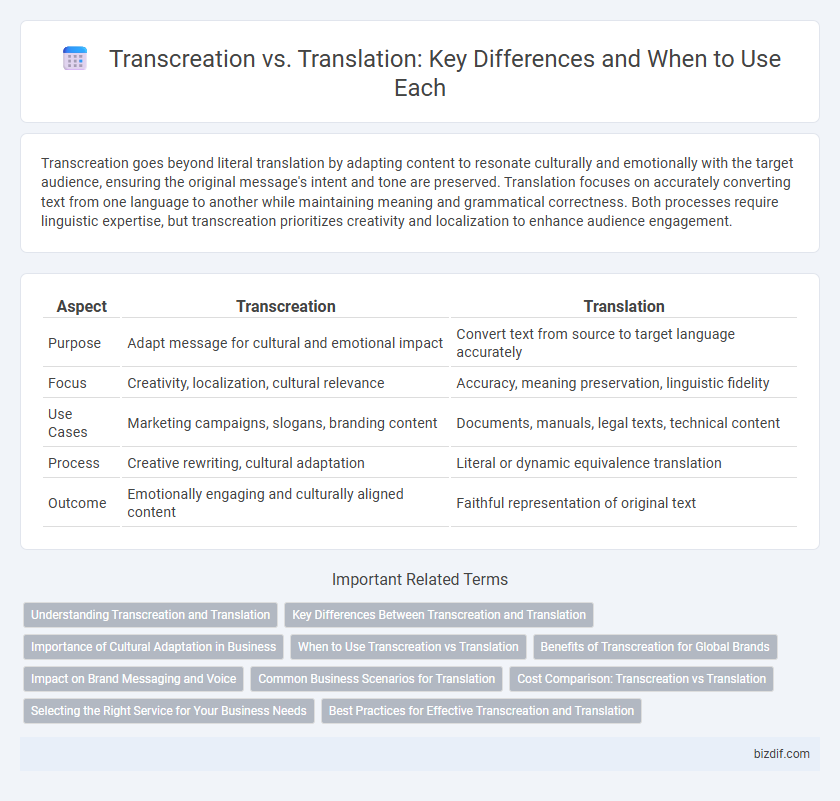Transcreation goes beyond literal translation by adapting content to resonate culturally and emotionally with the target audience, ensuring the original message's intent and tone are preserved. Translation focuses on accurately converting text from one language to another while maintaining meaning and grammatical correctness. Both processes require linguistic expertise, but transcreation prioritizes creativity and localization to enhance audience engagement.
Table of Comparison
| Aspect | Transcreation | Translation |
|---|---|---|
| Purpose | Adapt message for cultural and emotional impact | Convert text from source to target language accurately |
| Focus | Creativity, localization, cultural relevance | Accuracy, meaning preservation, linguistic fidelity |
| Use Cases | Marketing campaigns, slogans, branding content | Documents, manuals, legal texts, technical content |
| Process | Creative rewriting, cultural adaptation | Literal or dynamic equivalence translation |
| Outcome | Emotionally engaging and culturally aligned content | Faithful representation of original text |
Understanding Transcreation and Translation
Transcreation involves adapting content to suit the cultural and emotional context of the target audience, emphasizing creativity and localization beyond literal word-for-word translation. Translation focuses on accurately converting text from one language to another while preserving the original meaning and intent. Understanding the distinction between transcreation and translation is essential for businesses aiming to communicate effectively across diverse markets.
Key Differences Between Transcreation and Translation
Transcreation involves adapting content to preserve its intent, style, tone, and context, especially in marketing and advertising, while translation focuses on converting text from one language to another with accuracy. Key differences include the level of creativity required, with transcreation demanding cultural and emotional alignment to engage the target audience effectively, whereas translation emphasizes linguistic precision and fidelity. Transcreation often results in significantly altered content to suit local nuances, whereas translation maintains the original message's structure and meaning as closely as possible.
Importance of Cultural Adaptation in Business
Transcreation goes beyond literal translation by adapting content to resonate with the target culture's values, idioms, and preferences, which is crucial for effective business communication. Cultural adaptation enhances brand authenticity and emotional connection, leading to higher customer engagement and market success. Ignoring cultural nuances risks misinterpretation, damaging reputation and reducing the impact of marketing campaigns.
When to Use Transcreation vs Translation
Transcreation is essential when adapting marketing materials, slogans, or creative content that require cultural nuances and emotional impact beyond literal translation. Translation is suitable for technical documents, legal texts, or any content where accuracy and fidelity to the source text are paramount. Choosing between transcreation and translation depends on the goal: preserve brand voice and evoke audience emotion with transcreation, or ensure precise information transfer with standard translation.
Benefits of Transcreation for Global Brands
Transcreation enhances global brand messaging by adapting content to resonate emotionally and culturally with target audiences, ensuring greater engagement and brand loyalty. This approach preserves the original intent, tone, and style while localizing idioms, humor, and cultural references, which pure translation often overlooks. Brands employing transcreation experience improved communication effectiveness, higher conversion rates, and stronger market presence across diverse regions.
Impact on Brand Messaging and Voice
Transcreation preserves the original brand messaging while adapting cultural nuances, ensuring a consistent and emotionally resonant brand voice across diverse markets. Unlike literal translation, transcreation enhances brand impact by creatively tailoring content to local sensibilities, maintaining authenticity and engagement. This approach strengthens brand identity and fosters deeper connections with target audiences, driving brand loyalty and recognition globally.
Common Business Scenarios for Translation
Transcreation adapts content creatively to preserve intent, tone, and style, making it ideal for marketing campaigns and brand messaging across diverse cultures. Translation is commonly used in business scenarios such as legal documents, technical manuals, and financial reports where accuracy and clarity are critical. Companies often combine both practices to maintain consistent brand voice while ensuring precise communication in global markets.
Cost Comparison: Transcreation vs Translation
Transcreation typically incurs higher costs than standard translation due to the creative adaptation required to maintain brand voice and cultural relevance. While translation focuses on accurately converting text from one language to another, transcreation involves reimagining content to evoke the same emotional impact, demanding more time and expertise. Budget allocation should consider these differences, as transcreation often results in greater ROI for marketing campaigns despite its premium pricing.
Selecting the Right Service for Your Business Needs
Transcreation involves adapting content to convey the same emotional impact and cultural nuances, making it ideal for marketing and advertising materials targeting diverse audiences. Translation focuses on accurately converting text from one language to another, suitable for legal documents, technical manuals, and straightforward communication. Selecting the right service depends on your business goals, whether prioritizing cultural relevance or precise language conversion to effectively engage your target market.
Best Practices for Effective Transcreation and Translation
Effective transcreation and translation require a deep understanding of cultural nuances and target audience preferences to ensure the message resonates authentically. Collaborating with native speakers and subject matter experts enhances accuracy and preserves brand voice across languages. Consistent use of glossaries, style guides, and client feedback loops optimizes quality and maintains alignment with the original content's intent.
Transcreation vs Translation Infographic

 bizdif.com
bizdif.com